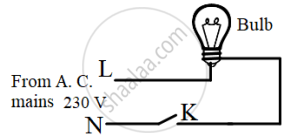Advertisements
Advertisements
प्रश्न
Explain the heating effect of electric current.
उत्तर
- When an electric current passes through a wire, the electrical energy is converted to heat.
- In heating appliances, the heating element is made up of materials with high melting point. An example of such a material is nichrome (an alloy of nickel, iron and chromium).
- The heating effect of electric current has many practical applications.
- The electric bulb, geyser, iron box, immersible water heater are based on this effect.
- These appliances have heating coils of high resistance.
- Generation of heat due to electric current is known as the heating effect of electricity.
APPEARS IN
संबंधित प्रश्न
Compute the heat generated while transferring 96000 coulomb of charge in one hour through a potential difference of 50 V.
Name any two effects of electric current.
The heat produced in a wire of resistance 'x' when a current 'y' flows through it in time 'z' is given by:
(a) x2 × y × z
(b) x × z × y2
(c) y × z2 × x
(d) y × z × x
In an electric bulb, coil of _______ metal is used.
(a) Observe the diagram given below and state whether the bulb will glow or not when we switch on K.

(b) Is it safe to handle the bulb when the switch is OFF?
(c) Give a reason for your answer in (b).
An electric fuse has a body made of ceramic and two points for connecting the fuse wire.
______ wire is used in the filament of the bulbs.
Assertion: A current-carrying wire should be charged.
Reason: The current in a wire is due to the flow of free electrons in a definite direction.
The electric fuse works on the Joule heating principle.
An electric kettle of 2 kW is used for 2h. Calculate the energy consumed in
- kilowatt hour and
- joules.
